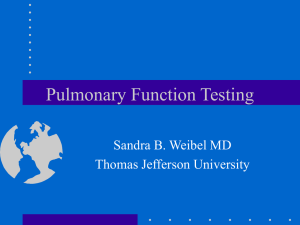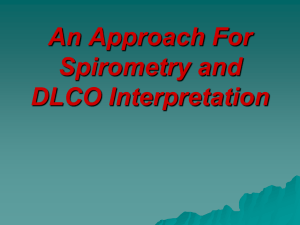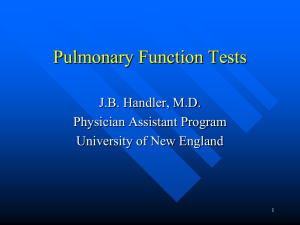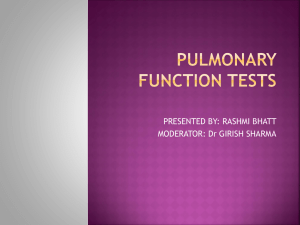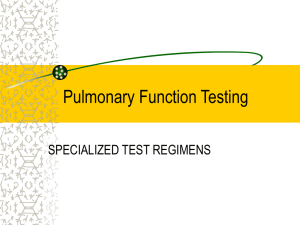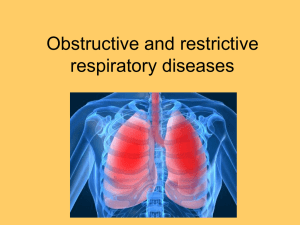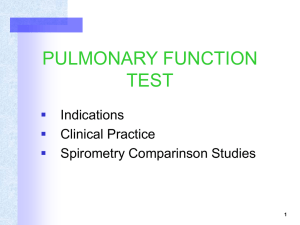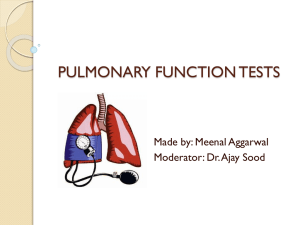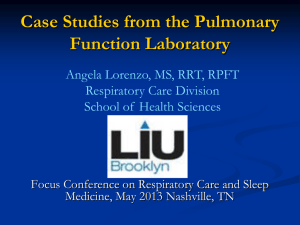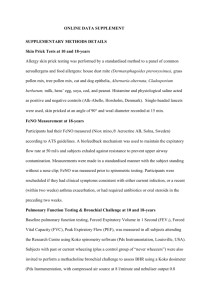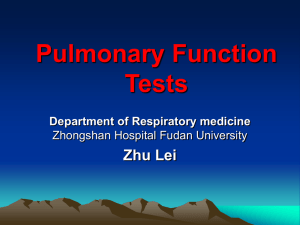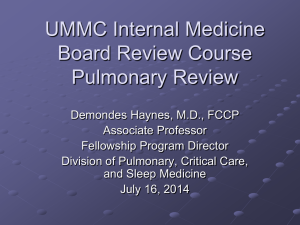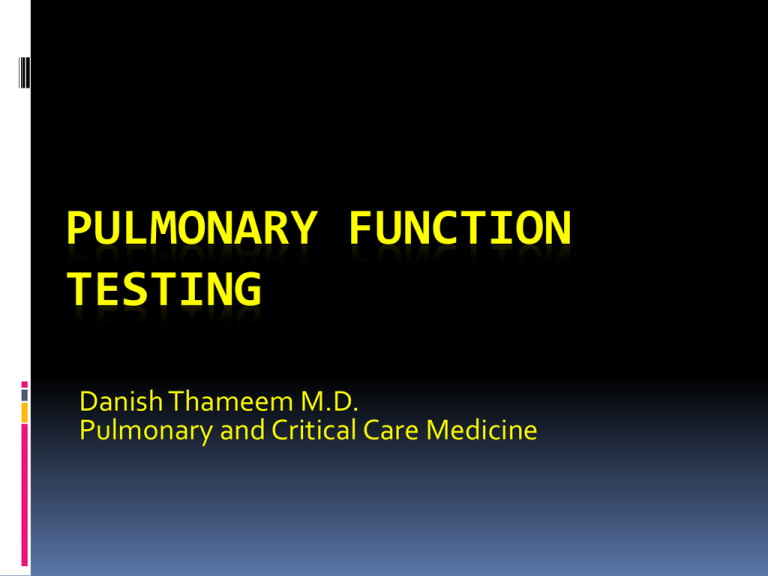
PULMONARY FUNCTION
TESTING
Danish Thameem M.D.
Pulmonary and Critical Care Medicine
Indications for Pulmonary
Functions
Evaluation of a pulmonary symptom
Evaluation of smokers without symptoms
Evaluation of workers exposed to hazards
Quantification of impairment
Evaluate response to therapy
Preoperative assessment
Disability evaluation
Timeline of cigarette smokers that develop obstructive lung disease.
Types of Pulmonary Function
Tests
Spirometry
Lung Volumes
Diffusion Capacity
Maximal Respiratory Pressures
Maximum Voluntary Ventilation (MVV)
Arterial Blood Gases
Pulse Oximetry
Bronchoprovocation
Lung Volumes Diagram
Lung Volumes and Capacities
Four Volumes
Four Capacities
VT
VC
IRV
IC
ERV
FRC
RV
TLC
General Approach to
Interpretation
Is the test interpretable?
Are the results normal? Or abnormal?
What is the pattern?
What is the severity?
What does this mean for the patient?
Acceptability Criteria for Spirograms
Free from artifacts
Cough or glottis closure during the first second of exhalation
Early termination or cutoff
Variable effort
Leak
Obstructed mouthpiece
Satisfactory exhalation
6 sec of exhalation and/or a plateau in the volume-time curve or
Reasonable duration or a plateau in the volume-time curve or
The subject cannot or should not continue to exhale
Repeatability Criteria
After three acceptable spirograms have been
obtained, apply the following tests
Are the two largest FVCs within 0.2 L of each other?
Are the two largest FEV1s within 0.2 L of each other?
If both of these criteria are met, the test session may be
concluded. If both of these criteria are not met, continue
testing until: Both of the criteria are met with analysis of
additional acceptable spirograms or
A total of eight tests have been performed or
Save a minimum of three best maneuvers
Spirometry
FVC (forced vital capacity): maximum volume of
air that can be exhaled during a forced maneuver
(after maximal forced inspiration, TLC)
FEV1 (forced expired volume in one second):
volume expired in the first second of maximal
expiration after a maximal inspiration
FEV1/FVC: FEV1 expressed as a % of FVC, a
clinically useful index of airflow limitation
Spirogram
Predicting Normal Values
Depend on patient’s
Height
Age
Gender
Racial & ethnic background
Weight & BMI (to a lesser degree)
Reference Standards
Percent Predicted as Normal
Range
Results are expressed as % Predicted of a
predicted normal value of a person the same
age, sex, and height. (FVC and FEV1)
Normal Ranges
FVC
80-120%
FEV1
80-120%
FEV1/FVC >0.70 of predicted ratio
Obstruction vs. Restriction
If the FVC and / or FEV1 is below normal
The distinction between obstruction &
restriction is based on the FEV1/FVC ratio
NIH/WHO - GOLD guidelines recommends
using ratio below 0.70 for the diagnosis of
COPD
Obstructive Lung Disease
Emphysema & Chronic Bronchitis
Cystic Fibrosis
Asthma
Bronchiectasis
Some Interstitial Lung Disease: (combined)
Restrictive Pattern
Normal or elevated FEV1/FVC ratio
With a low FEV1 or FVC suggests restriction
Lung Volumes are needed to confirm
Some patients with Asthma or COPD may
have this pattern (“pseudorestriction”)
Restrictive Lung Disease
Rating of Severity
May be based on statements such as from the
American Thoracic Society (ATS)
Obstructive Pattern - FEV1
Restrictive Pattern – TLC (lung volumes)
If lung volumes not obtained - FVC
ATS/ERS Standardization of Lung Function Testing:
Interpretative Strategies for lung function tests - 2005
Classification of COPD by
Severity
GOLD Guidelines - 2009
I: Mild
FEV1/FVC < 70%; FEV1 > 80% predicted
II: Moderate FEV1/FVC < 70%; 50% < FEV1 < 80%
III: Severe
FEV1/FVC < 70%; 30% < FEV1 <50%
IV: Very
Severe
FEV1/FVC < 70%; FEV1 < 30% predicted
or FEV1 < 50% predicted plus chronic
respiratory failure
Bronchodilator Response
Must use bronchodilator with rapid onset
•
•
Increase FEV1 or FVC from baseline
•
•
Albuterol
Levalbuterol
By at least 12%
By at least 200 mL
Both values must be met
FLOW VOLUME LOOPS
Normal
Upper Airway Obstruction
Patterns
Detect obstructive lesions in the major airways.
Characterizes the lesion:
Location of the lesion:
Intrathoracic
Extrathoracic
Behavior of the lesion in rapid inspiration and expiration:
Fixed
Variable
Variable Extrathoracic
Obstruction
Levitzky MG Pulmonary Physiology,
McGraw Hill 4th ed, 1995, p 50
Vocal cord paralysis
Goiter
Tumor
Variable Intrathoracic
Obstruction
Levitzky MG Pulmonary Physiology,
McGraw Hill 4th ed, 1995, p 50
Tracheomalacia
Intratracheal tumor
Fixed Obstruction
Levitzky MG Pulmonary Physiology,
McGraw Hill 4th ed, 1995, p 50
Tracheal stenosis/stricture
Bilateral vocal cord paralysis
Extrinsic compression
Lung Volumes
Lung Volumes Diagram
Lung Volumes in Lung
Diseases
Lung Volumes
TLC
Obstructive Lung
Disease
Restrictive Lung
Disease
Increased
Decreased
(Hyperinflation)
RV
Increased
Decreased
(Airtrapping)
VC
Normal or Decreased
Decreased
RV/TLC
Increased
Normal (30-40)
Diffusion Capacity
Estimates the transfer of
oxygen in the alveolar air
to the red blood cell.
Factors that influence the
diffusion:
1) Area of the alveolar-capillary
membrane (A)
2) Thickness of the membrane (T)
3) Driving pressure
4) Hemoglobin
5) Carboxyhemoglobin
Diffusing Capacity
Single-breath DLCO measures the capacity of the lung to
transfer gas
Patient exhales to RV then rapidly inhales gas mixture
with minute amount of CO. After, 10 second breath-hold
at TLC, the patient rapidly exhales & the exhaled gas is
analyzed to measure the amount of CO transferred into
the capillary blood during the maneuver
Abnormalities of Diffusing
Capacity
Decreased in conditions that disrupt the
alveolar-capillary surface for gas transfer
Loss of surface area (resection, fibrosis,
emphysema, pneumonia)
Reduced lung capillary volume (vasculitis,
thromboembolism, primary pulm htn, ILD)
Increased diffusion distance (PAP, PCP)
Abnormalities of Diffusing
Capacity
Increased by conditions that lead to
recruitment of pulmonary vascular bed and
increase in capillary blood volume
(exercise, mild CHF, asthma)
Or by increased amount of hemoglobin which
binds CO
(pulmonary hemorrhage, erythrocytosis)
CASE 1
54 y/o male smoker
PFT
FEV1 : 1.3 L (23%)
FVC : 2.3 L (45%)
FEV1/FVC : 56
TLC 98%
RV : 156%
DLCO : 30%
Diagnosis
Very severe obstructive defect
Severe reduction in DLCO
High RV
Air trapping
COPD
CASE 2
35 y/o F with SLE
FEV1 : (56%)
FVC : (45%)
FEV1/FVC 90
TLC : 48%
RV: 45%
DLCO : 23%
FEV1 increased by 4%
(0.1 L) with
bronchodilator testing
Diagnosis
Severe restriction without significant
response to bronchodilators
Severe reduction in DLCO
ILD
PULMONARY FIBROSIS
CASE 3
45 y/o female with history of allergic rhinitis
and dyspnea on exertion
FEV1 - 3.2 (70%) pre, 4.5 (100%) post BD
FVC - 4.9 (70%) pre, 6.0 (85%) post BD
RATIO - 65% pre and 75% post
TLC - 6 L (100%)
DLCO - 100%
Diagnosis
Mild obstruction with significant response to
bronchodilators (normal)
Normal lung volumes and DLCO
ASTHMA
CASE 4
76 y/o male with weight loss and dyspnea
FEV1 - 4 L ( 85%)
FVC - 5.1 L (80%)
RATIO - 78%
TLC - 6 L ( 82%)
DLCO - 88%
Diagnosis
Normal spirometry
Truncated inspiratory limb of the flow volume
loop
EXTRATHORACIC OBSTRUCTION

